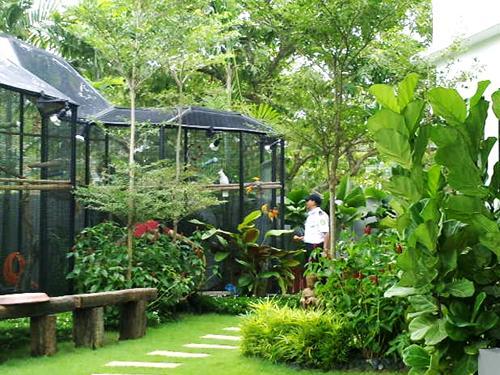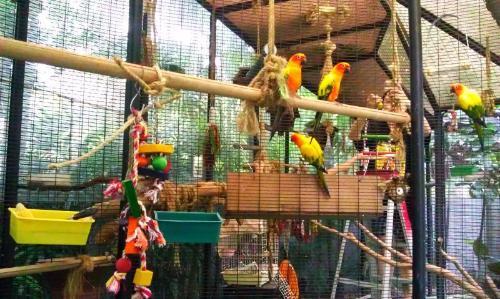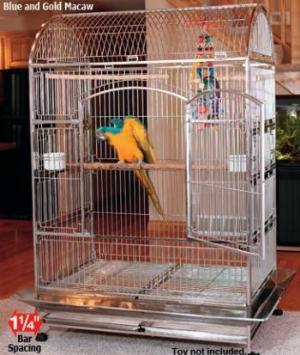BUILDING AN AVIARY
Construction of an Aviary
First things first, before you can build an aviary, you will need to do a little bit of home work. Our beautiful Ladrang aviary was built by JP Thong and it was built with these requirements in mind to give our avian friends the best and most comfortable home. Below are some guidelines to help you, if you wish to build your own aviary....
Research materials you could use to build the aviary.
- Certain types of wood can be poisonous to birds and some metal materials can chip easily, which can also cause health problems. Professionals advise using non-coated galvanized steel for the cage, and ceramic, concrete, brick or linoleum for the floor of your aviary.
Decide if you want your aviary indoors or outdoors. This may affect the size and materials you decide to use.
- Weather conditions and predators are important considerations when building an outside aviary, while maintenance and ventilation are key for an indoor aviary.
- You can structure your aviary so that it is portable for both inside and outside use.
Plan for a larger aviary rather than a small one.
- An aviary can be any size but you'll want to accommodate for the size of your bird and give him enough room to fly: at least twice the wingspan for width, six times the body for length and four times the body for height.
- Budget space for additions like nests or branches.
Building Your Aviary


 of Aki.jpg?timestamp=1343566288481)

The above aviaries in Tsem Ladrang was constructed by Liaison JP Thong
and the interiors with its perches, toys, bird houses was set up by Liaison Ooi Beng Kooi & Justin Ripley.
Start with the floor.
- If you use concrete as recommended, lay 12 inches for the foundation. You can add a layer of sand, gravel or pine to the concrete to sweep up with waste during cleaning.
- You may also want to "plant" non-toxic foliage in the concrete while it's setting or at least leave enough space.
Build the frame.
- Stone, metal, plastic or brick piping work, as well as treated lumber.
Construct the walls and roof with welded wire.
- Parameters and wire spacing are dependent on the size of birds you want to house in the aviary.
- You'll want to make sure the wire is heavy enough that your bird can't break it, usually 10-gauge or heavier.
Make an entrance.
- Whether you make the entrance or purchase a ready-made door, make sure it is a double-door to prevent escape.
Provide shelter, especially if it's an outdoor aviary or a portable aviary for indoor and outdoor use.
- At least one-third of the aviary should be enclosed. Fasten material--plastic, Plexiglas, cloth or hardwood: to two or three sides of the aviary and the roof.
- You can also add insulation and a heater.
Protect your bird from predators.
- Add another layer of wiring or mesh to prevent predators from getting too close to your bird. A 1/2-inch-by-1/2-inch wire will thwart opossums, rats and cats. Even smaller wire can prevent snakes and mice from accessing the aviary.
- If you set the aviary on the ground, you'll also want to make sure that other animals cannot dig to get inside. Digging 6 inches down and around the perimeter can help.
On a Budget
If one is limited by budget, an alternative to building an elaborate aviary is bird cage.
Choosing
the right bird cage is critical to ensure optimum quality of life for your
bird. Generally the rule of thumb is that bigger is better. This is all very well, but your choice of
cage must take into account the type of bird(s) you have, your budget and the
area of space you have available for the cage.
It should be placed away from windows and drafts, preferably in the
social hub of your house so that your pet birds get interaction with people.
Choosing the right size cage:
Size relates to the size of the cage itself and the bar spacing. The table below is a good general guide to how big the cage needs to be and how widely the bars may be spaced. If your particular species of bird is not listed here, look at a bird that is of similar size; also take into account the main activities of that species.
Note: all dimensions are given in inches and in the format width x length x height.
|
Species |
Minimum
Cage |
Bar Spacing |
|
Finches |
18"x30"x18" |
1/4" to 1/2" |
|
Canaries |
18"x24" x18" |
1/4" to 1/2" |
|
Budgies |
18"x18"x24" |
1/2" |
|
Cockatiels |
20"x20"x24" |
1/2" to 5/8" |
|
Lovebirds |
24"x24"x24 |
1/2" |
|
Ringneck Parakeets |
24"x24"x36" |
1/2" to 5/8" |
|
Conures |
24"x24"x24" |
5/8" to 3/4" |
|
Caiques |
24"x24"x36" |
5/8" to 3/4" |
|
Amazons |
24"x36"x48" |
3/4" to 1" |
|
Large Cockatoos |
36"x48"x48" |
1" to 1.5" |
|
Large Macaws |
36"x48"x60" |
1" to 1.5" |
The bird cage you purchase should be large enough for your bird to walk around comfortably, and they should be able to fully extend and flap their wings. They need to be able to perform these activities even when all the perches and toys are inside the cage
Metal vs. wood, which is better and why?
Stainless steel cages are the safest, most durable choice - they are non-toxic and easy to clean. Wooden cages can splinter, which puts the bird at risk of injury. Metal cages are easy to disinfect, and are highly resistant to stains, rust and corrosion. Wooden cages also tend to be painted, often with paint that will be harmful to the bird if flakes of the paint are ingested. Wooden or painted surfaces are additionally very difficult to clean thoroughly.
The importance of mental stimulation:
Birds, especially parrots, are highly sociable creatures that require a
great amount of mental stimulation. There are many things you can do to enrich
their environment and prevent them from becoming bored and potentially
destructive. Interacting with your
bird on a daily basis will not only improve the bond between you and your bird
but provide it with the social stimulation it requires. Birds enjoy learning and teaching them new
tricks will often be a rewarding form of interaction for you as well.
For the times when you are not at home ensure your bird has some toys available to keep it occupied. The choice of toys is endless, old favorites like mirrors with bells attached are always popular with birds, along with food sticks and treat toys like the Parrot Woodroll (for parrots and parakeets) or Boredom Breakers (for budgies and canaries). The food toys will also help to keep the beak worn down to an appropriate level also.
The importance of perches:
It is important to have perches inside the cage as birds will naturally spend most of their time on these if given the choice. The width of the perch should correspond to the size of the bird. For example, parrots generally require thicker and stronger perches than budgies or canaries due to their size and weight. There are many different types of perch available. Some, like Smart Perch, are gently textured and contoured for grip and are also safe for your bird to nibble on (they have a wood-like texture but do not splinter). Another good option is a rubber, bendable perch. These are suitable for most bird cages.
Make the environment fun for your bird by adding in perches and trees that it can climb, as well as several nest
boxes. Make sure perches are far enough from the edge of the aviary that it won't invite predators.
Source: http://www.medicanimal.com/viewarticle/~contentId=MA19791/~nodeTrailCsv=AR-BIRDS-PIGEONS,MA19791
Different types of Bird Cages can be obtained in most Pet shops such at Ikano Pet Safari and Pet Wonderland

